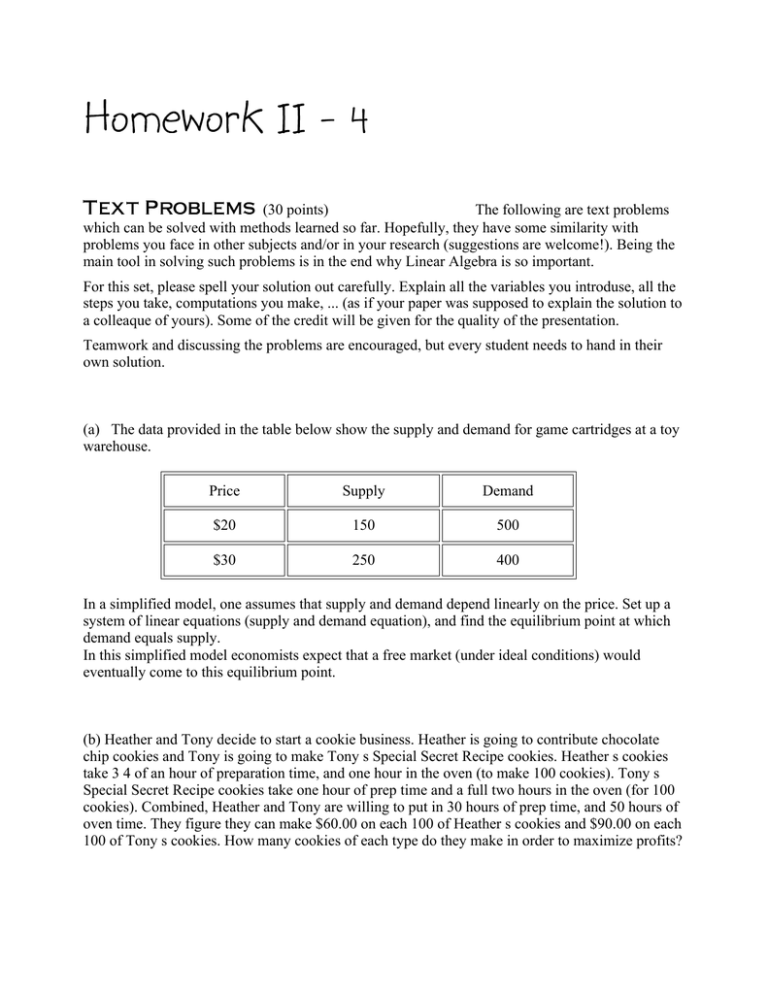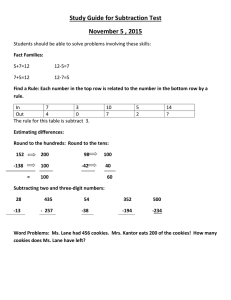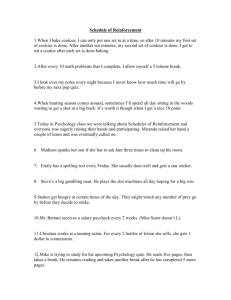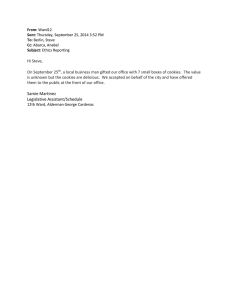Part 4
advertisement

(30 points) The following are text problems which can be solved with methods learned so far. Hopefully, they have some similarity with problems you face in other subjects and/or in your research (suggestions are welcome!). Being the main tool in solving such problems is in the end why Linear Algebra is so important. For this set, please spell your solution out carefully. Explain all the variables you introduse, all the steps you take, computations you make, ... (as if your paper was supposed to explain the solution to a colleaque of yours). Some of the credit will be given for the quality of the presentation. Teamwork and discussing the problems are encouraged, but every student needs to hand in their own solution. (a) The data provided in the table below show the supply and demand for game cartridges at a toy warehouse. Price Supply Demand $20 150 500 $30 250 400 In a simplified model, one assumes that supply and demand depend linearly on the price. Set up a system of linear equations (supply and demand equation), and find the equilibrium point at which demand equals supply. In this simplified model economists expect that a free market (under ideal conditions) would eventually come to this equilibrium point. (b) Heather and Tony decide to start a cookie business. Heather is going to contribute chocolate chip cookies and Tony is going to make Tony s Special Secret Recipe cookies. Heather s cookies take 3 4 of an hour of preparation time, and one hour in the oven (to make 100 cookies). Tony s Special Secret Recipe cookies take one hour of prep time and a full two hours in the oven (for 100 cookies). Combined, Heather and Tony are willing to put in 30 hours of prep time, and 50 hours of oven time. They figure they can make $60.00 on each 100 of Heather s cookies and $90.00 on each 100 of Tony s cookies. How many cookies of each type do they make in order to maximize profits? (c) Consider the following electrical circuit. R denotes resistance, E voltage, and i denotes current. These laws descibing the relations in the circuit are known from physics: Ohm's Law: E = Ri holds for the voltage, current and resistance between any two points Kirchoff Junction Rule: At any junction point, the sum of all currents entering the junction must equal the sum of all currents leaving the junction. Kirchoff Loop Rule: The algebraic sum of all voltage (changes in potential) around any closed path of a circuit must be zero. Find the strength of the currents i1, i2, and i3 in the three branches of above circuit. (d) One group of customers at a snack bar bought 8 cheesburgers, 6 orders of fries and 6 drinks for a total of $26.10. A second group bought 10 cheeseburgers, 6 orders of fries and 8 drinks for a total of $31.30. A third group bought 3 cheeseburgers, 2 orders of fries and 4 drinks for a total of $10.95. Find the price of each food item purchased. (e) One day, a student learns in class, that in an n-dimensional vectorspace there can't be more than n linearly independent vectors. Curios if that's really true the student goes and playes around with examples. In the end he decides that maybe most likely perhaps he found a counterexample: 1 1 0 1 0 1 , , , 0 0.25 0 1 1.5 1 0 0 , 2 0 2 1.5 0 1 Is he right? If not, give an example for non-zero coefficients for which a linear combination of these vectors vanishes. (Hint: Set up a system of linear equations with the coefficients as variables.)





